h2 hide
Estoy listo para aprender a comer la mayoría de las comidas que haces.
Qué
- Dame porciones pequeñas de varias comidas que yo pueda comer fácilmente.
- Necesito comidas blandas, tiernas y húmedas, como vegetales cocidos y frutas blandas.
- Todavía me encanta que me amamantes, ¡pero tomar leche humana en un vaso también es genial!
Cómo
- Ofréceme comidas de un plato o tazón pequeño.
- Quiero elegir si uso la mano o la cuchara. Tenme paciencia si soy desprolijo.
- Córtame la comida en trozos pequeños, del tamaño de un bocado, no más grandes que la uña de tu pulgar.
Cuándo
- Lo mejor son tres comidas (desayuno, almuerzo, cena) y dos o tres bocadillos. Comamos a la misma hora todos los días.
- Solo necesito agua entre las comidas y los bocadillos. De esta manera, cuando llegue la hora de la próxima comida o bocadillo, tendré hambre, pero no demasiada.
Dónde
- Come conmigo. Necesito tu ayuda y aprendo mucho durante las comidas familiares. El tiempo que pasamos juntos es especial. Me siento muy amado cuando me prestas atención.
- Déjame comer en la mesa con todos los demás. Necesito estar a salvo, sentado, apoyado y sujeto en una silla alta.
- Estos son algunos ejemplos de cómo se verían los tamaños de las porciones de comidas y bocadillos en mi plato.
Estos son algunos ejemplos de cómo se verían los tamaños de las porciones de comidas y bocadillos en tu plato.
Desayuno
h4 hide
¼ de taza de kiwi cortado en cubos
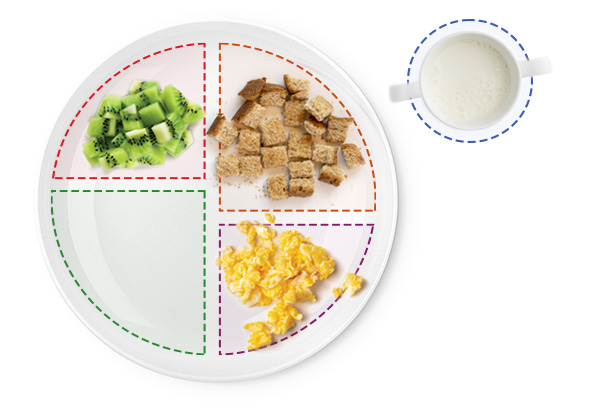
½ rebanada de pan tostado integral cortado
½ huevo cocido, cortado en trozos
½ taza de leche humana o leche entera
Almuerzo
h4 hide
½ banana mediana en rebanadas
½ taza de frijoles verdes cocidos y picados
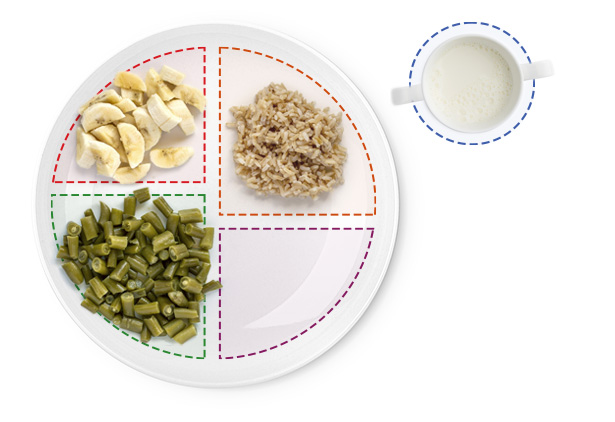
¼ de taza de arroz integral cocido
½ taza de leche humana o leche entera
Bocadillos
h4 hide
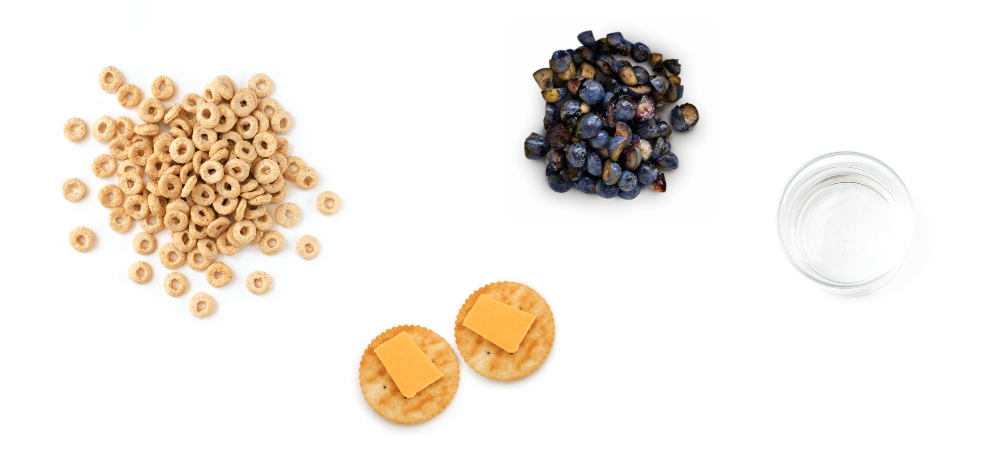
½ taza de cereal seco
2 a 3 galletas integrales con queso
½ taza de arándanos picados
agua entre comidas y bocadillos
Cena
h4 hide
¼ de taza de fresas cortadas en cubos
½ taza de puré de guisantes
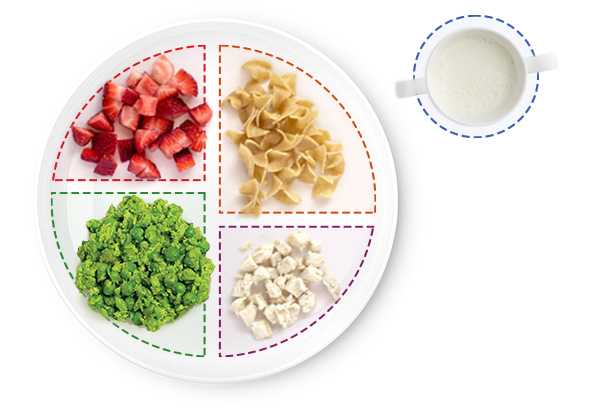
¼ de taza de pasta integral cocida
2 cucharadas de pollo picado al horno
½ taza de leche humana o leche entera
Cantidades diarias sugeridas de grupos de alimentos
½-1 taza al día
Fruta cocida, o blanda y cruda.
En puré, en rebanadas o picadas.
Ofrece variedad: roja, amarilla, naranja, azul y verde.
⅔-1 taza al día
Vegetales cocidos y en puré, en rebanadas o picados.
Ofrece variedad: verde oscuro, naranja, rojo, amarillo y morado.
1¾-3 onzas al día
Piezas del tamaño de un bocado.
Pan, tortillas, arroz o fideos integrales.
Cereal seco o cocido.
1¾-3 onzas al día
Piezas del tamaño de un bocado.
Pan, tortillas, arroz o fideos integrales.
Cereal seco o cocido.
2 onzas al día
Carne de res, aves o pescado cocidos y picados.
Huevos.
Frijoles o guisantes cocidos y en puré.
Mantequilla de cacahuate.
2 onzas al día
Carne de res, aves o pescado cocidos y picados.
Huevos.
Frijoles o guisantes cocidos y en puré.
Mantequilla de cacahuate.
1⅔-2 tazas al día
Leche humana (del pecho o extraída) o leche entera.
Yogur.
Queso.
1⅔-2 tazas al día
Leche humana (del pecho o extraída) o leche entera.
Yogur.
Queso.
¡Mira lo que puedo hacer!
- Puedo beber de un vaso pequeño de plástico en las comidas y con los bocadillos.
- Estoy aprendiendo a usar cuchara.
- Me encanta aprender a caminar contigo.
- Puede que sepa cómo decir algunas palabras. Léeme, háblame y cántame para que pueda aprender más.
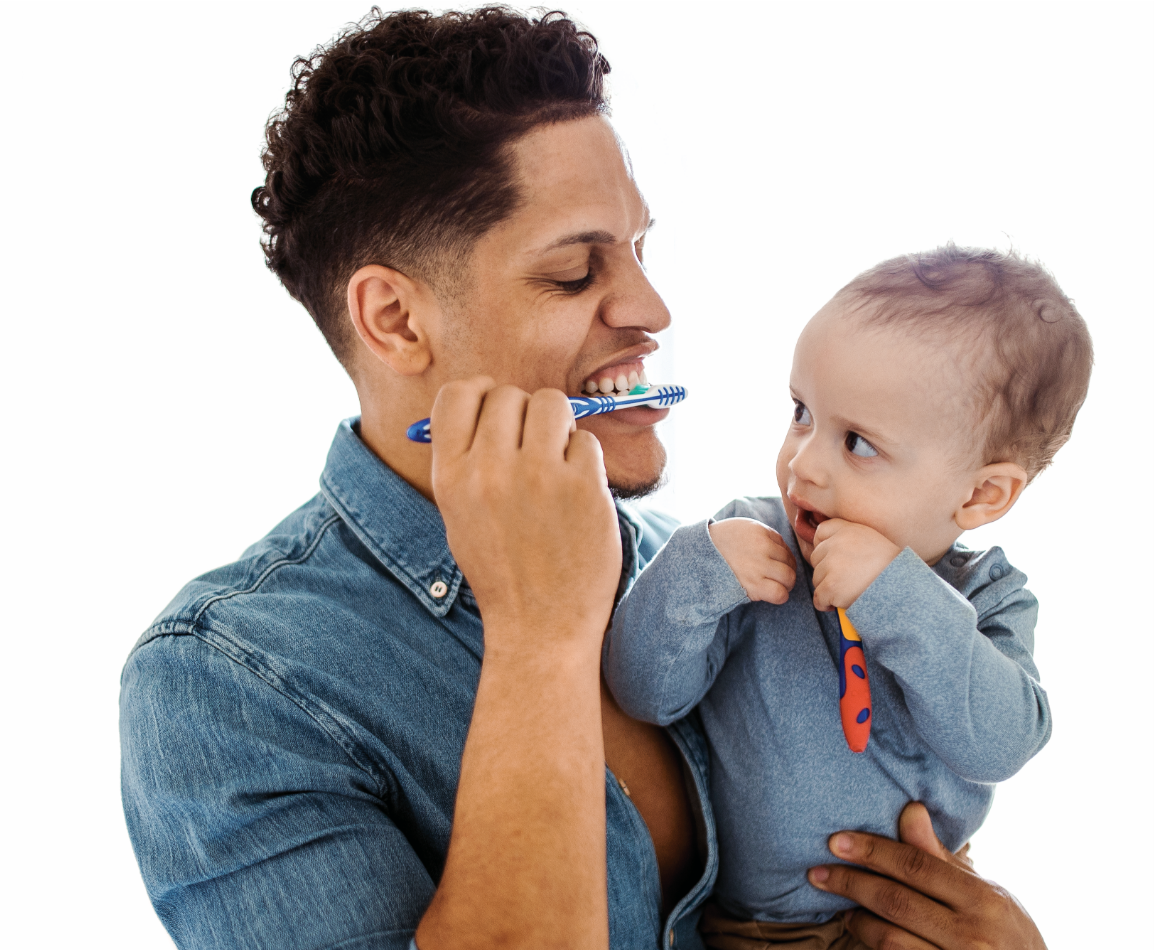
Mantenme sano y a salvo
NO me des comidas con las que me pueda ahogar, como nueces enteras, uvas enteras, semillas, perritos calientes o caramelos duros.
Necesito que me realicen chequeos y me apliquen vacunas para estar sano. Debo visitar al médico a los 12 meses, 15 meses y 18 meses. Visita www.cdc.gov/vaccines/schedules para ver cuándo deben aplicarme las vacunas.
Cepíllame los dientes dos veces al día con un cepillo de dientes pequeño y suave y una pequeña cantidad de pasta de dientes para niños, del tamaño de un grano de arroz. Pide una cita para ver al dentista.
Juega conmigo y ayúdame a mantenerme activo. Si uso pantallas, es mejor que sea de manera limitada y que interactúes conmigo.
Evita consumir productos de tabaco o nicotina, alcohol, marihuana y otras drogas ilegales para mantener a nuestra familia sana y segura. Para obtener ayuda para dejar el tabaco o los productos de nicotina, visita www.quitnow.net. Para obtener ayuda para dejar el alcohol o las drogas, visita www.findtreatment.gov. Tu nutricionista del Special Supplemental Nutrition Program for Women, Infants and Children (WIC, Programa Especial de Nutrición Suplementaria para Mujeres, Infantes y Niños) también puede darte recursos adicionales.
Esta institución es un proveedor que ofrece igualdad de oportunidades.